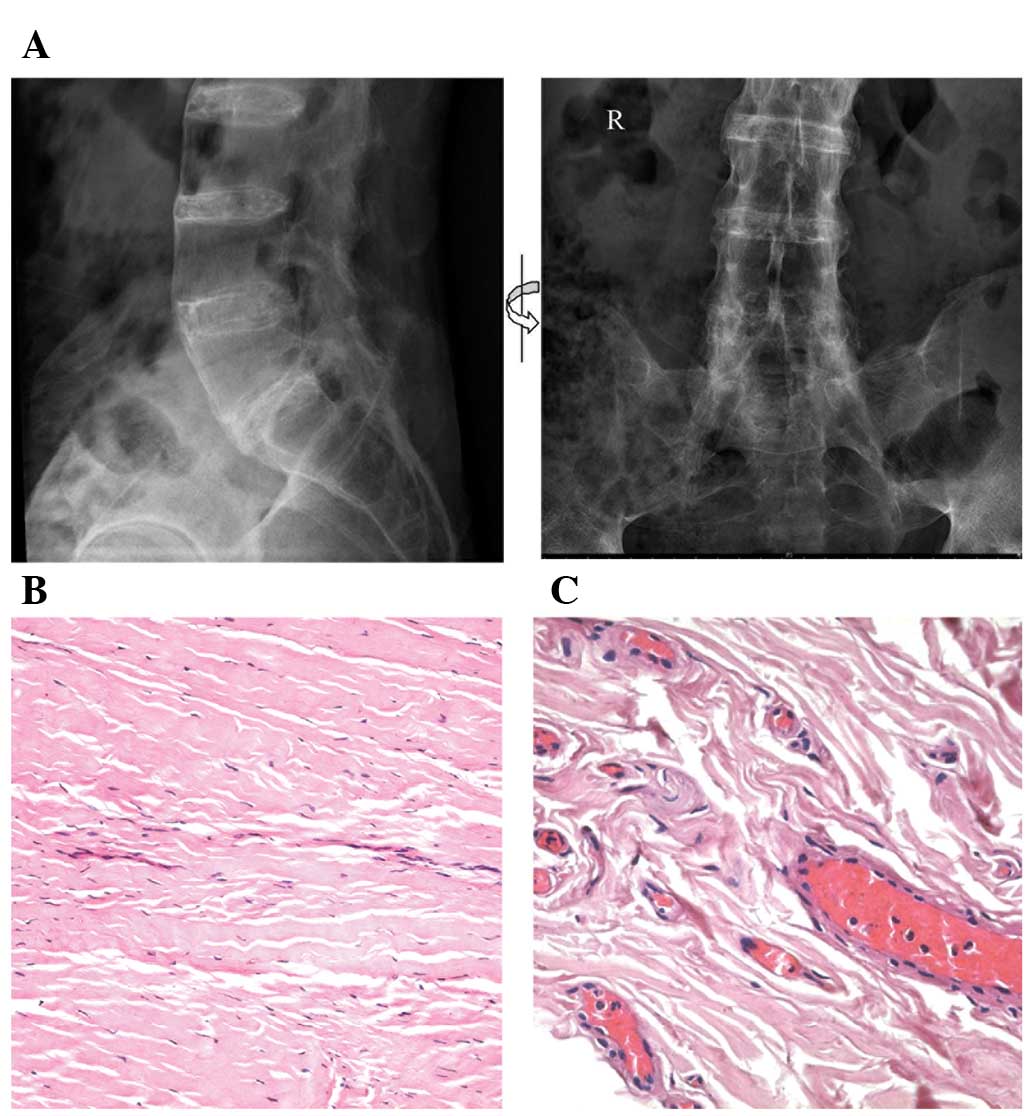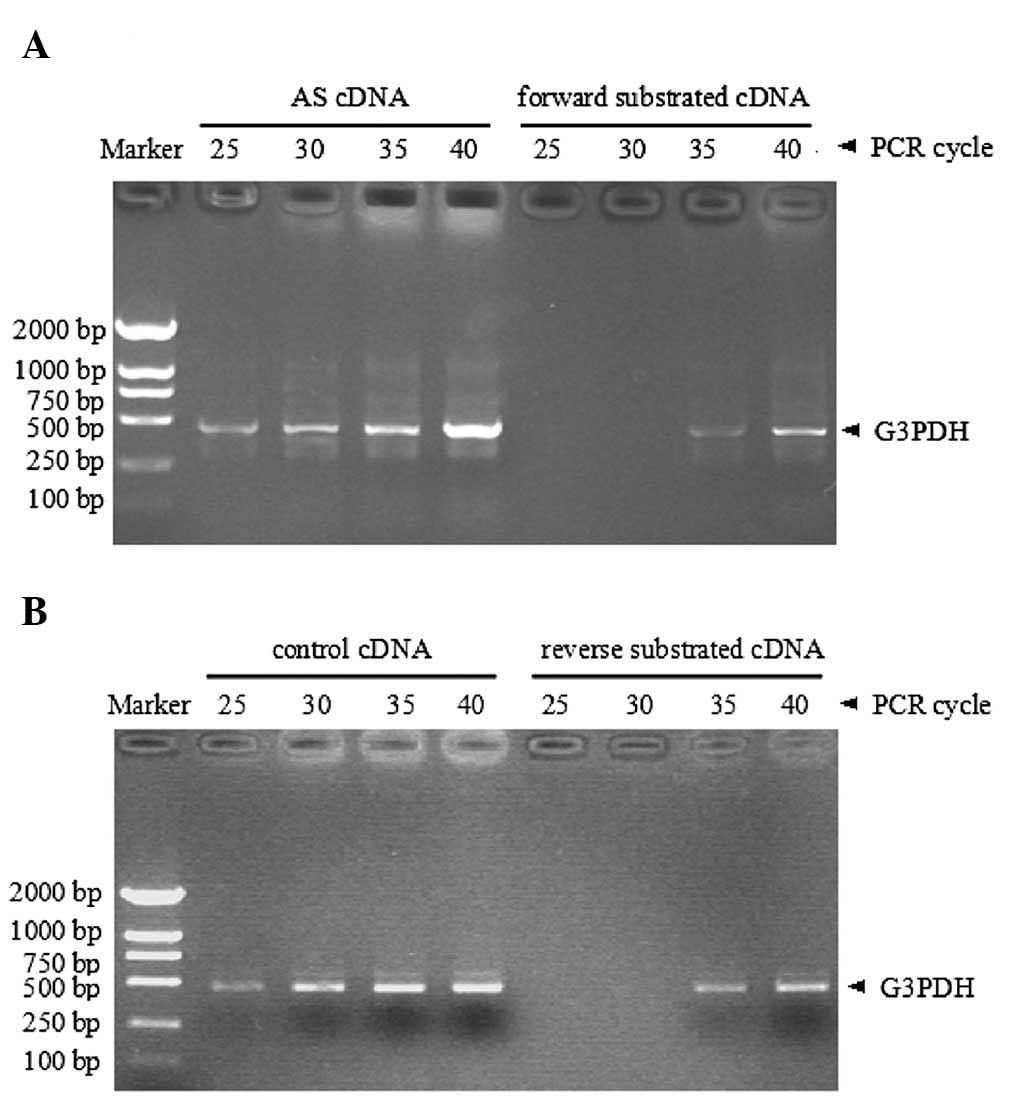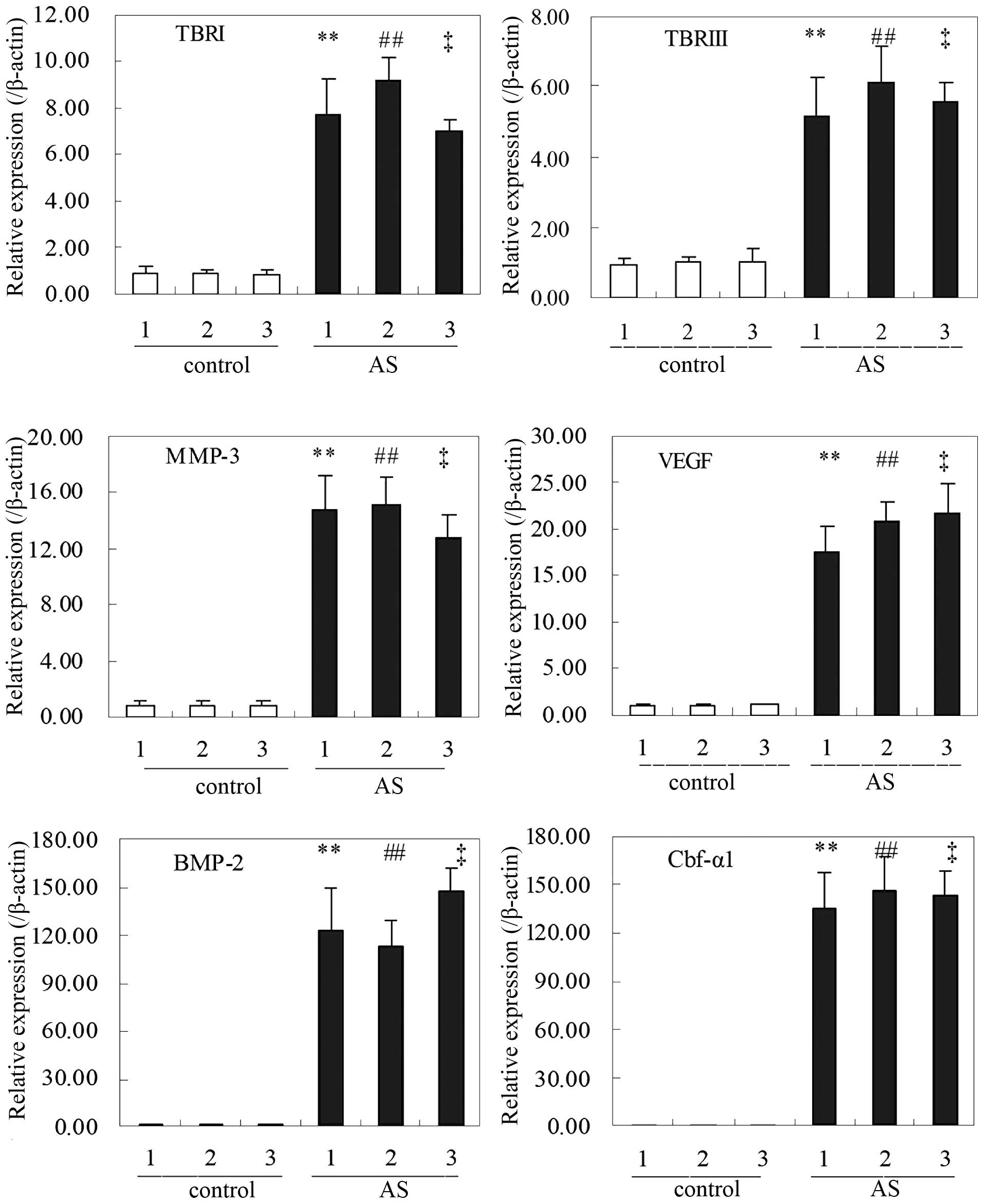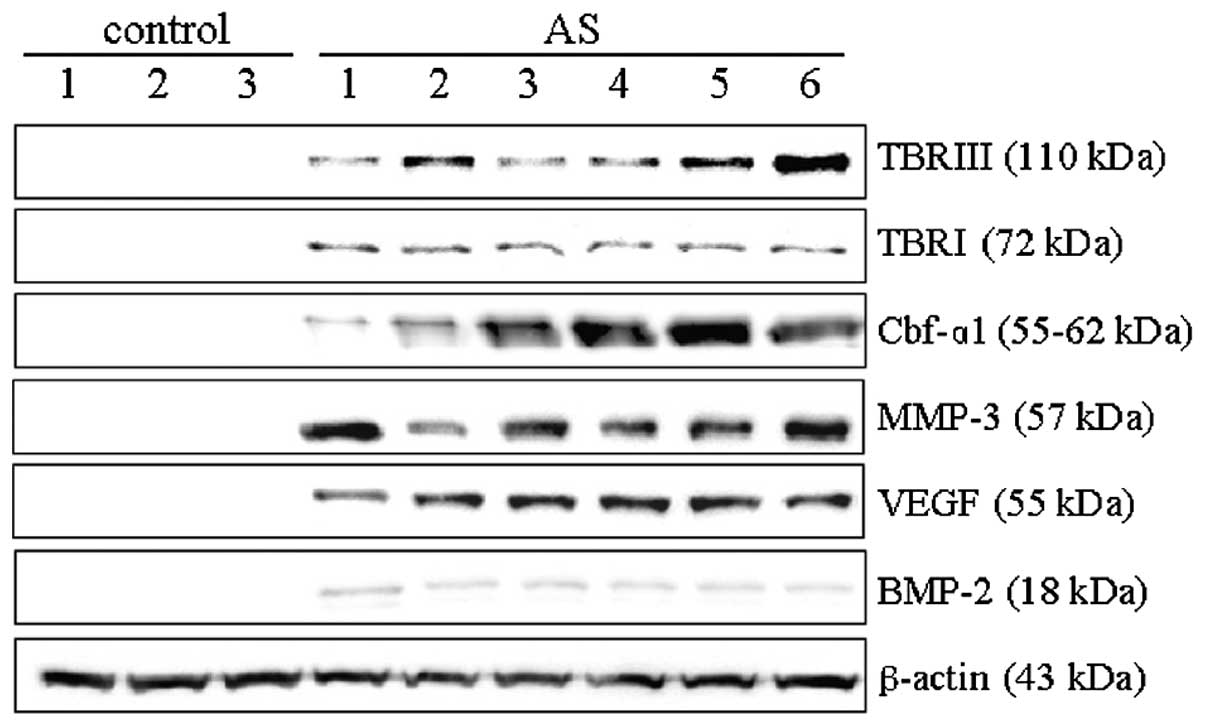Suppression subtractive hybridization reveals differentially expressed genes in supraspinous ligaments of patients with ankylosing spondylitis
- Authors:
- Published online on: January 29, 2015 https://doi.org/10.3892/mmr.2015.3272
- Pages: 4482-4488
Abstract
Introduction
Ankylosing spondylitis (AS) is a severe chronic inflammatory disease that affects the sacroiliac joints and axial skeleton. AS is characterized primarily by inflammatory back pain, which may lead to structural and functional impairment, and ultimately the development of a ‘bamboo-like’ spine (1–3). A significant proportion of AS patients are young adults. As there is currently no effective cure for this disease, morbidity from AS results in a high burden on families, as well as society in general (4,5).
The pathogenesis of AS is complex and remains poorly understood. Hereditary factors are hypothesized to be the primary etiological agent, although infection, metabolic disorders and autoimmune disorders may also be involved (3,6). The gene encoding human leukocyte antigen B27 (HLA-B27) is understood to be the most important genetic factor associated with AS (7). However, additional genes associated with an increased susceptibility to this disease have been identified. These include genes encoding HLA-B60 (8), killer cell immunoglobulin-like receptors (9), interleukin family members (10,11) and tumor necrosis factor α (TNF-α) (12). However, these genetic alterations do not fully explain the pathogenesis of AS, in particular uncontrolled bone formation and subsequent spinal fusion.
Uncontrolled bone formation occurs during the pathogenesis of AS, resulting in spinal fusion and disability (4). Thus, spinal fusion is thought to be the most serious consequence of AS (13,14). A previous study identified alterations in the supraspinal ligaments of patients with AS, including irregular arrangements of collagen fibrils, degeneration of fibroblasts, significant increases in microvessel density and calcification of tissue (15). This phenotype suggests a tendency to osteogenesis in the supraspinal ligaments of those with AS, indicating that further investigation of the molecular changes present in supraspinal ligaments may improve understanding of the pathogenesis of spinal fusion in patients with AS.
In order to assess the molecular changes associated with spinal fusion, polymerase chain reaction (PCR)-based suppression subtractive hybridization (SSH) was conducted, using supraspinal ligaments of patients with AS and from healthy controls. Differentially expressed genes (DEGs) between the two groups were identified, and the mRNA and protein expression patterns of six DEGs were determined.
Materials and methods
Clinical samples
Paraspinal tissues were obtained via spinal orthopedic surgery from six patients (four males and two females; mean age, 30.2 years) who were in the active stage of AS, according to the criteria described by the American Rheumatism Association (16). The X-ray imaging of patients were carried out with a Definium 6000 (GE Healthcare, Wauwatosa, WI, USA). Paraspinal tissues were also obtained during reattachment surgery from three patients (two males and one female; mean age, 31.5 years) who had sustained spinal fractures. Supraspinous ligaments were carefully isolated from these tissue samples, washed with phosphate-buffered saline (0.01 mM, pH 7.2; Sangon Biotech Co., Ltd, Shaghai, China) and then immediately stored in liquid nitrogen, or fixed in 4% paraformaldehyde solution (Sangon Biotech Co., Ltd) and embedded in paraffin (Sangon Biotech Co., Ltd). The study protocol was approved by the ethics committee of Xinqiao Hospital (Chongqing, China). All patients provided written informed consent for the experimental use of the obtained materials.
Pathological assessment
Pathological assessment was performed as previously described (1,17). Briefly, paraffin-embedded supraspinous ligaments were cut into thin slices and stained with hematoxylin and eosin (Sangon Biotech Co., Ltd). Following dehydration, transparency and drying, all sections were evaluated by a pathologist who was blinded to patient diagnosis using a microscope (IX71, Olympus Corp., Tokyo, Japan) and Analysis FIVE software version 5.0 (Olympus Corp.).
SSH
Frozen tissue samples were ground in liquid nitrogen and total RNA was extracted using RNAiso plus (Takara, Dalian, China). PolyA+ mRNA was isolated from total RNA using PolyATract kits (Promega Corp., Madison, WI, USA). A 2-μg aliquot of each mRNA sample was used as a template in order to generate double-stranded cDNA (dscDNA) using a SMART PCR cDNA synthesis kit (Clontech, Palo Alto, CA, USA).
SSH was performed using PCR-select cDNA subtraction kits (Clontech) according to the manufacturer’s instructions. Three independent SSH experiments using the AS and control samples were conducted. Briefly, forward and reverse SSH were simultaneously performed in each independent SSH experiment. During forward SSH, the dscDNA of the AS samples was set as the Tester and the dscDNA of the control samples as the Driver (Tester and Driver were set according to the instructions). For reverse SSH, the Tester and Driver dscDNAs were exchanged. Each dscDNA was digested with RsaI (Clontech), and the blunt-ended products were ligated with adaptor. The Tester and Driver were hybridized twice, with the product used as a PCR template in order to amplify differentially expressed cDNAs. Throughout the SSH procedure, the efficiency of dscDNA synthesis, RsaI digestion, adaptor ligation and subtractive hybridization were monitored according to the manufacturer’s instructions.
Construction of subtracted cDNA libraries
Differentially expressed cDNAs synthesized by SSH were recycled, inserted into a pMD-19T vector (Takara) and subsequently used to transform competent Escherichia coli DH5α (Takara). The transformed cells were selected using Luria-Bertani agar plates containing ampicillin, X-gal and IPTG (Sangon Biotech Co., Ltd). Colonies containing inserts (white colonies) were assayed by colony PCR using the following procedure: Denature at 94°C for 5 min, followed with 30 cycles (94°C for 30 sec, 58°C for 30 sec, and 72°C for 30 sec). The primer pair was as follows: Nested PCR primer 1, 5′-TCGAGCGGCCGCCCGGGCAGGT-3′ and nested PCR primer 2R, 5′-AGCGTGGTCGCGGCCGAGGT-3′ (Clontech). The PCR products were electrophoresed on agarose gels to confirm the presence and size of the inserts prior to sequencing.
Sequencing analysis
Differentially expressed cDNA fragments from subtracted cDNA libraries were sequenced by Invitrogen Life Technologies (Shanghai, China) and the sequences were evaluated using Chromas software. Contig Express (New York, NY, USA) performed contig assembly and the obtained sequences were analyzed using the basic local alignment search tool for nucleotides (BLASTn; www.blast.ncbi.nlm.nih.gov) to search for homologous sequences. Kyoto Encyclopedia of Genes and Genomes (KEGG; http://www.genome.jp/kegg/pathway analysis was performed in order to identify the function of the relevant genes. Only genes which were present in the results of all three independent SSH experiments were defined as DEGs and used for subsequent experiments.
Validation of mRNA expression
Total RNA samples were reverse-transcribed using the PrimeScript RT reagent kit (Takara) and cDNA samples were used as templates for reverse transrciption-quantitative PCR (RT-qPCR) using the primers listed in Table II. RT-qPCR was performed using a CFX Connect™ Cycler with SsoAdvanced™ SYBR Green supermix (Bio-Rad Laboratories, Inc., Hercules, CA, USA) according to the manufacturer’s instructions. The expression levels of each DEG were normalized to those of β-actin mRNA and calculated using the 2−ΔΔCT method with SPSS version 13.0 (SPSS, Inc., Chicago, IL, USA) as previously described (18).
Western blot analysis
Total proteins were extracted from frozen tissue samples using IP Cell Lysis Reagent (Beyotime, Haimen, Jiangsu, China). Proteins were separated by 10% SDS-PAGE and transferred to polyvinylidene difluoride membranes (EMD Millipore, Billerica, MA, USA). The membranes were blocked at 37°C with 5% non-fat milk (Beyotime) and incubated overnight with 1:1,000 dilutions (Beyotime) of polyclonal rabbit-derived antibodies against human β-actin and vascular endothelial growth factor (VEGF; both from Beyotime), human bone morphogenetic protein 2 (BMP-2) and matrix metalloproteinase-3 (MMP-3; both from Santa Cruz Biotechnology, Inc., Dallas, TX, USA) and core binding factor-α1 (Cbf-α1), human transforming growth factor-β type I (TBRI) and TBRIII (all from Cell Signaling Technology, Inc., Danvers, MA, USA). The blots were washed with PBS containing 0.5% Tween-20 (Sangon Biotech Co., Ltd) and incubated with secondary goat anti-rabbit or anti-mouse immunoglobulin G antibodies (Beyotime; 1:10,000). Protein bands were visualized with the SuperSignal West Pico chemiluminescence substrate (Thermo Pierce, Rockford, IL, USA) using a ChemiDoc XRS Gel Imaging System (Bio-Rad Laboratories, Inc.).
Statistical analysis
The levels of mRNA expression are presented as the mean ± standard deviation and were compared using Student’s t tests using SPSS version 13.0 (SPSS, Inc.). P<0.05 was considered to indicate a statistically significant difference.
Results
Pathological changes in supraspinal ligaments
Pelvic X-ray images of a patient with AS demonstrated typical spinal fusion (Fig. 1A). The pathological changes in the supraspinal ligaments of patients with AS, which were subsequently used in the SSH experiments, and in control patients with spinal fractures were examined by light microscopy. Histological examination demonstrated that the collagen fibrils of control ligaments were regularly arranged and filled with diffuse extracellular matrix, with spindle-like fibroblasts running parallel to these fibrils (Fig. 1B). By contrast, the collagen fibrils of ligaments from patients with AS were irregularly organized and did not contain extracellular matrix. Furthermore, fewer fibrils were observed in these samples, in which there was also evidence of hyaline degeneration (Fig. 1C).
Efficiency of SSH
The efficiency of each SSH experiment involving glyceraldehyde 3-phosphate dehydrogenase (G3PDH) cDNA, was tested by quantitative comparison of subtracted and unsubtracted cDNA. PCR products were detectable following 25 cycles in the AS unsubtracted sample, compared with >10 cycles in the forward subtracted sample (Fig. 2A). Similarly, G3PDH PCR products were detected following 25 cycles in the unsubtracted control sample, whereas >10 cycles were required in the reverse subtracted sample (Fig. 2B).
Characterization of the subtracted cDNA libraries
Two cDNA libraries, forward and reverse, were constructed by PCR-based SSH from the supraspinal ligaments of patients with AS and control patients in each independent SSH experiment. On average, ~200 differentially expressed cDNA fragments from the forward subtracted cDNA library and ~150 from the reverse library were identified in each SSH experiment. Prior to sequencing, all clones were isolated and assayed by colony PCR for the presence of cDNA inserts and in order to estimate the size of each product. In the SSH experiments under optimized conditions, a total of 212 clones, 153 from the forward and 59 from the reverse libraries, were isolated and sequenced, with insert sizes ranging from 67 to 839 bp. Following removal of the vector sequences and low-quality expressed sequence tags (ESTs), the average available sequence was ~319 bp in length.
The cleaned ESTs of each SSH experiment were subsequently assembled. Using the BLASTn tool, all sequences from forward or reverse libraries demonstrated significant similarity with genes from the GenBank database (http://www.ncbi.nlm.nih.gov/genbank/). A total of 27 DEGs were presented in all of the three forward libraries. All of these were functionally annotated in the KEGG; http://www.genome.jp/kegg/ online server. These genes are thus candidate DEGs associated with AS, and are listed in Table I.
Confirmation of differentially expressed mRNA
In order to confirm the differential gene expression pattern in supraspinous ligaments from patients with AS, six upregulated DEGs were selected based on functional annotations. Although inflammation-associated genes, including tumor necrosis factor α (TNF-α), interleukin-1β (IL-1β) and interleukin 23 receptor (IL-23R) are hypothesized to be involved in the pathogenesis of AS (19,20), the present study focused on spinal fusion rather than inflammation. Primers for these genes were designed using Primer Premier 5 software (Table II). Reverse transcription-quantitative PCR (RT-qPCR) analyses of the same AS and control samples as those used for SSH experiments were performed in order to quantify the expression of mRNAs encoded by the candidate genes. Theoretically, the expression levels of expression of each candidate gene would be higher in the samples from patients with AS than those in the samples from control patients.
RT-qPCR analyses showed that, in accordance with the results of the SSH experiments, the levels of mRNAs encoding the six proteins TBRI/III, VEGF, MMP-3, Cbf-α1 and BMP-2 were significantly increased in AS samples as compared with those in the control samples (Fig. 3).
Confirmation that the encoded proteins are differentially expressed
In order to further investigate the expression of these six DEGs, western blot analysis was conducted using total protein extracted from the supraspinal ligaments of the six patients with AS and three control subjects. An increased expression of all six proteins was detected in the samples from patients with AS as compared with those in the three controls (Fig. 4). Furthermore, these proteins were not detected at all in the control samples, although their mRNA was present at low levels. These results indicated that TBRI, TBRIII, VEGF, Cbf-α1, BMP-2 and MMP-3 proteins are abundantly expressed in the supraspinal ligaments of patients with AS.
Discussion
Chronic inflammation, back pain, bone erosion and syndesmophyte formation are characteristic features of AS (6,21), with bone formation and subsequent spinal fusion being fundamental causes of AS-associated disability. Whilst histopathological changes have been observed in the spinal tissues of patients with AS (1,5,17), the molecular mechanisms underlying spinal fusion remain elusive. There are currently no available methods of reversing the process of spinal fusion, with the exception of orthopedic spinal surgery.
PCR-based SSH, which is distinct from microarray technology, is a rapid and sensitive method for the identification of DEGs. SSH directly provides partial sequences of DEGs, including scarce or novel genes. Genes that were differentially expressed in the supraspinous ligaments of AS compared with those of control patients were identified using SSH. The three forward libraries yielded 27 genes defined as DEGs in the AS samples. While the association between HLA-B27 and AS was identified in patients aged >30 years (7), it was not detected in AS supraspinous ligaments via SSH. However, differential expression of inflammation-associated genes, including IL-1β, TNF-α and IL-23R, which are hypothesized to be associated with the development of AS (20,22), was detected. RT-qPCR and western blot analyses identified six candidate proteins, TBRI, TBRIII, VEGF, MMP-3, Cbf-α1 and BMP-2, as being associated with AS, but not inflammation, and contributing to spinal fusion.
Members of the TGF-β superfamily are known to be important regulators of cell proliferation, differentiation, morphogenesis, apoptosis cancer and heritable disorders (23). TGF-β was shown to promote downstream signaling pathways through three cell surface receptors: TBRI, TBRII and TBRIII. TBRI and TBRII were identified as serine/threonine kinases. Following ligand binding, TBRI recruits TBRII and the two receptors form a stable heteromeric complex on the cell surface. TBRII phosphorylates and activates TBRI (24). TBRIII is an abundant cell surface proteoglycan, characterized as a ubiquitously-expressed transmembrane receptor that acts as a TGF-β and inhibin receptor (25). TBRIII has a large extracellular domain, which tightly binds TGF-β with a high affinity (26). TBRIII regulates TGF-β signaling by presenting it to the activated TBRI/TBRII complex. The present study demonstrated that TBRI and TBRIII were highly expressed in the supraspinal ligaments of patients with AS, compared with those from control patients, suggesting that there is excessive activation of TGF-β signaling within AS tissues. This increase in activation may contribute to uncontrolled bone formation and spinal fusion.
TBRIII also acts as a BMP-2 co-receptor, increasing the quantity of BMP-2 that binds to the BMP signaling receptors, activin-like receptor kinases 3 (ALK3) and ALK6 (26). BMP-2 is an essential regulator of bone development and facilitates osteoblastic differentiation and bone formation (26). Of note, BMP-2 and TBRIII were highly expressed in all of the AS samples examined, indicating that excess activation of the BMP-2/TBRIII pathway may be a bone morphogenetic mechanism that contributes to spinal fusion in patients with AS.
Cbf-α1 is an important osteoblast-specific transcription factor that may differentially activate osteoblasts during embryonic development (27). In the absence of Cbf-α1, osteoblast differentiation and bone development have been shown to be limited (28). The present study demonstrated that the levels of Cbf-α1 mRNA and protein were markedly higher in AS than those in control samples, suggesting that Cbf-α1 may contribute to spinal fusion in patients with AS.
During skeletal development, bone formation is known to be coupled to angiogenesis (29). VEGF is an endothelial cell growth factor, which is an early marker of angiogenesis and also a marker of bone formation (30). The present study showed that VEGF expression was higher in the samples from patients with AS than that in control samples, indicating that VEGF may also contribute to spinal fusion.
The present study demonstrated that the expression of MMP-3 mRNA and protein was higher in AS samples than that in control samples. MMP-3 has been shown to be an important mediator of bone matrix and cartilage damage (31). Recent reports have suggested that MMP-3 may also serve as a biomarker with which to assess disease activity in patients with AS (32), and for monitoring the response of patients to drug treatment in clinical practice (33). Damage to articular surfaces and cartilage that occurs in spinal joints are considered to be the significant degenerative changes during the early pathogenesis of spinal fusion (3). Although, to the best of our knowledge, there is no evidence to suggest that MMP-3 primes bone formation, it may participate in the process of spinal joint damage, thereby contributing to spinal fusion during the development of AS.
In conclusion, the present study isolated six DEGs, namely TBRI, TBRIII, VEGF, MMP-3, Cbf-α1 and BMP-2, in the supraspinal ligaments of patients with AS. These six DEGs were hypothesized to be potential osteogenic factors associated with excessive bone formation during AS. Further investigations are required in order to determine whether any of these genes participate in bone formation and subsequent spinal fusion during the pathogenesis of AS.
Acknowledgments
This study was supported by the National Natural Science Foundation of China (grant no. 81071523) and the Natural Science Foundation of Chongqing (grant no. CSTC 2011BA5009). The authors would like to thank the staff and patients at the Department of Orthopaedics of Xinqiao Hospital (Chongqing, China) who participated in this study.
References
|
Appel H, Kuhne M, Spiekermann S, et al: Immunohistochemical analysis of hip arthritis in ankylosing spondylitis: evaluation of the bone-cartilage interface and subchondral bone marrow. Arthritis Rheum. 54:1805–1813. 2006. View Article : Google Scholar : PubMed/NCBI | |
|
Chou CH, Lin MC, Peng CL, et al: A nationwide population-based retrospective cohort study: increased risk of acute coronary syndrome in patients with ankylosing spondylitis. Scand J Rheumatol. 43:132–136. 2014. View Article : Google Scholar | |
|
Braun J and Sieper J: Ankylosing spondylitis. Lancet. 369:1379–1390. 2007. View Article : Google Scholar : PubMed/NCBI | |
|
Thomas GP and Brown MA: Genomics of ankylosing spondylitis. Discov Med. 10:263–271. 2010.PubMed/NCBI | |
|
Lories RJ and Baeten DL: Differences in pathophysiology between rheumatoid arthritis and ankylosing spondylitis. Clin Exp Rheumatol. 27(Suppl 55): S10–S14. 2009. | |
|
Tam LS, Gu J and Yu D: Pathogenesis of ankylosing spondylitis. Nat Rev Rheumatol. 6:399–405. 2010. View Article : Google Scholar : PubMed/NCBI | |
|
Khan MA, Mathieu A, Sorrentino R and Akkoc N: The pathogenetic role of HLA-B27 and its subtypes. Autoimmun Rev. 6:183–189. 2007. View Article : Google Scholar : PubMed/NCBI | |
|
Wei JC, Tsai WC, Lin HS, Tsai CY and Chou CT: HLA-B60 and B61 are strongly associated with ankylosing spondylitis in HLA-B27-negative Taiwan Chinese patients. Rheumatology (Oxford). 43:839–842. 2004. View Article : Google Scholar | |
|
Diaz-Peña R, Blanco-Gelaz MA, Suárez-Alvarez B, et al: Activating KIR genes are associated with ankylosing spondylitis in Asian populations. Hum Immunol. 69:437–442. 2008. View Article : Google Scholar : PubMed/NCBI | |
|
Kim TH, Stone MA, Rahman P, et al: Interleukin 1 and nuclear factor-kappaB polymorphisms in ankylosing spondylitis in Canada and Korea. J Rheumatol. 32:1907–1910. 2005.PubMed/NCBI | |
|
McGarry F, Neilly J, Anderson N, Sturrock R and Field M: A polymorphism within the interleukin 1 receptor antagonist (IL-1Ra) gene is associated with ankylosing spondylitis. Rheumatology (Oxford). 40:1359–1364. 2001. View Article : Google Scholar | |
|
van Sijl AM, van Eijk IC, Peters MJ, et al: Tumour necrosis factor blocking agents and progression of subclinical atherosclerosis in patients with ankylosing spondylitis. Ann Rheum Dis. 2013.Epub ahead of print. View Article : Google Scholar : PubMed/NCBI | |
|
Feldtkeller E and Braun J: Impact of sex on inheritance of ankylosing spondylitis. Lancet. 355:1096–1097; author reply 1098. 2000. View Article : Google Scholar : PubMed/NCBI | |
|
Davey-Ranasinghe N and Deodhar A: Osteoporosis and vertebral fractures in ankylosing spondylitis. Curr Opin Rheumatol. 25:509–516. 2013. View Article : Google Scholar : PubMed/NCBI | |
|
Xu HF, Zhang L, Zhang Y and Chu TW: Histopathologicai and ultra-structural observation of the supraspinal ligaments in ankylosing spondylitis. Chinese Journal of Rheumatology. 17:152–154. 2013.In Chinese. | |
|
Arnett FC, Edworthy SM, Bloch DA, et al: The American Rheumatism Association 1987 revised criteria for the classification of rheumatoid arthritis. Arthritis Rheum. 31:315–324. 1988. View Article : Google Scholar : PubMed/NCBI | |
|
Appel H, Loddenkemper C, Grozdanovic Z, et al: Correlation of histopathological findings and magnetic resonance imaging in the spine of patients with ankylosing spondylitis. Arthritis Res Ther. 8:R1432006. View Article : Google Scholar : PubMed/NCBI | |
|
Pan X, Yue J, Ding G, et al: Leucine-rich repeat 11 of Toll-like receptor 9 can tightly bind to CpG-containing oligodeoxy-nucleotides, and the positively charged residues are critical for the high affinity. J Biol Chem. 287:30596–30609. 2012. View Article : Google Scholar : PubMed/NCBI | |
|
Stone MA, Inman RD, Wright JG and Maetzel A: Validation exercise of the Ankylosing Spondylitis Assessment Study (ASAS) group response criteria in ankylosing spondylitis patients treated with biologics. Arthritis Rheum. 51:316–320. 2004. View Article : Google Scholar : PubMed/NCBI | |
|
Hreggvidsdottir HS, Noordenbos T and Baeten DL: Inflammatory pathways in spondyloarthritis. Molecular immunology. 57:28–37. 2014. View Article : Google Scholar | |
|
Gratacós J, Collado A, Filella X, et al: Serum cytokines (IL-6, TNF-alpha, IL-1 beta and IFN-gamma) in ankylosing spondylitis: a close correlation between serum IL-6 and disease activity and severity. Br J Rheumatol. 33:927–931. 1994. View Article : Google Scholar : PubMed/NCBI | |
|
Stone MA and Inman RD: The genetics of cytokines in ankylosing spondylitis. J Rheumatol. 28:1203–1206. 2001.PubMed/NCBI | |
|
Massagué J, Blain SW and Lo RS: TGFbeta signaling in growth control, cancer, and heritable disorders. Cell. 103:295–309. 2000. View Article : Google Scholar : PubMed/NCBI | |
|
Derynck R, Akhurst RJ and Balmain A: TGF-beta signaling in tumor suppression and cancer progression. Nat Genet. 29:117–129. 2001. View Article : Google Scholar : PubMed/NCBI | |
|
Blobe GC, Schiemann WP, Pepin MC, et al: Functional roles for the cytoplasmic domain of the type III transforming growth factor beta receptor in regulating transforming growth factor beta signaling. J Biol Chem. 276:24627–24637. 2001. View Article : Google Scholar : PubMed/NCBI | |
|
Kirkbride KC, Townsend TA, Bruinsma MW, Barnett JV and Blobe GC: Bone morphogenetic proteins signal through the transforming growth factor-beta type III receptor. J Biol Chem. 283:7628–7637. 2008. View Article : Google Scholar : PubMed/NCBI | |
|
Ducy P, Starbuck M, Priemel M, et al: A Cbfa1-dependent genetic pathway controls bone formation beyond embryonic development. Genes Dev. 13:1025–1036. 1999. View Article : Google Scholar : PubMed/NCBI | |
|
Otto F, Thornell AP, Crompton T, et al: Cbfa1, a candidate gene for cleidocranial dysplasia syndrome, is essential for osteoblast differentiation and bone development. Cell. 89:765–771. 1997. View Article : Google Scholar : PubMed/NCBI | |
|
Portal-Núñez S, Lozano D and Esbrit P: Role of angiogenesis on bone formation. Histol Histopathol. 27:559–566. 2012.PubMed/NCBI | |
|
Clarkin CE and Gerstenfeld LC: VEGF and bone cell signalling: an essential vessel for communication? Cell Biochem Funct. 31:1–11. 2013. View Article : Google Scholar | |
|
Maksymowych WP: Biomarkers in spondyloarthritis. Curr Rheumatol Rep. 12:318–324. 2010. View Article : Google Scholar : PubMed/NCBI | |
|
Soliman E, Labib W, el-Tantawi G, Hamimy A, Alhadidy A and Aldawoudy A: Role of matrix metalloproteinase-3 (MMP-3) and magnetic resonance imaging of sacroiliitis in assessing disease activity in ankylosing spondylitis. Rheumatol Int. 32:1711–1720. 2012. View Article : Google Scholar | |
|
Arends S, van der Veer E, Groen H, et al: Serum MMP-3 level as a biomarker for monitoring and predicting response to etanercept treatment in ankylosing spondylitis. J Rheumatol. 38:1644–1650. 2011. View Article : Google Scholar : PubMed/NCBI |













